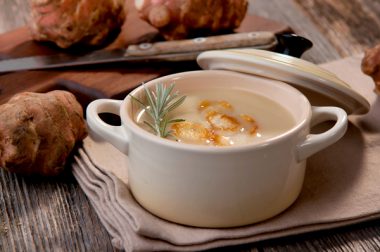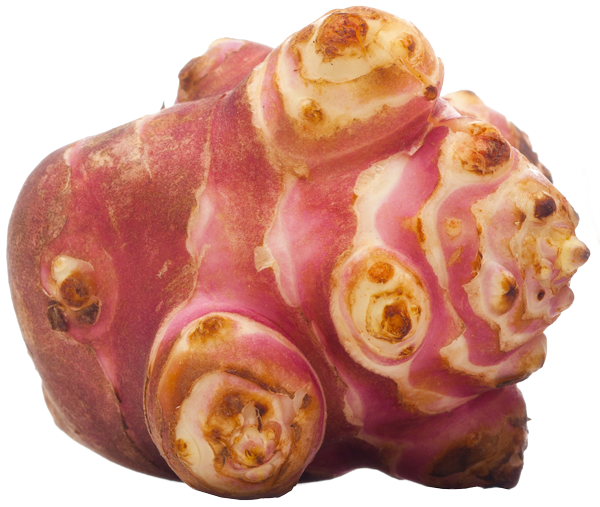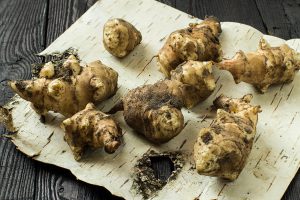Recipes we love
See all recipesJerusalem artichoke and bacon lardon cake
Remember, cakes are very high in fat and calories. By increasing the amount of vegetables, you can s...
Lambs lettuce salad with Jerusalem artichokes
This tasty, vitamin-packed lambs lettuce starter provides rare and valuable nutrients, making it a g...
Health
benefits
A boon for your digestion!
Jerusalem artichokes are low in calories and a source of fiber. They mainly contain inulin, a fermentable fiber that performs multiple beneficial functions in the colon, including bowel movement regulation. Inulin also gives Jerusalem artichokes their sweet flavor. High in potassium and low in sodium, Jerusalem artichokes help stimulate waste elimination.
Jerusalem artichokes are also:
- a source of potassium (for the nervous system, muscular function, and blood pressure)
They also contain:
- vitamin B1
- vitamin B3
- iron
Nutritional composition
When is the right time to eat them?
Fall and winter.
Jerusalem artichokes are typically winter vegetables. They are available in stores from fall until early spring (November to March).
Vegetable patch
or urban balcony?
Jerusalem artichokes (Helianthus tuberosus, from the Asteraceae family) are cold hardy, rhizomatous perennials (i.e. with perennial subterranean stems) that grow well in humus-rich soil, drained and without too much moisture, as well as in full sun or partial shade.
To learn everything you need to know about growing Jerusalem artichokes, read the page on growing advice.
Choosing and storing
Jerusalem artichokes
Choosing your Jerusalem artichokes well:
- It’s normal for Jerusalem artichokes have an irregular shape.
- Their firm texture is a sign of freshness.
Storing your Jerusalem artichokes well:
- They are more delicate than potatoes and should be stored in the vegetable drawer of the refrigerator for a few days, possibly even a week if they are stored in a plastic bag.
Tips and tricks
How to prepare Jerusalem artichokes
A small, knotty, crunchy vegetable that looks like a misshapen potato or a ginger root, Jerusalem artichokes have the same texture and refreshing taste as water chestnuts.
Once they are peeled, sprinkle them with lemon juice to prevent oxidation. Note that they are easier to peel after cooking!
They can be eaten boiled, steamed, fried or in soup.
Cooking time:
- 20 mins: in boiling water. Don’t cook them for too long or they’ll crumble, like potatoes.
- 10 mins: in a pan, after being scalded.
- 25 mins: steamed.
- 45 mins: in the oven.
Jerusalem artichokes go well with…
Raw: Young Jerusalem artichokes can be included raw in salads, as long as they are sprinkled with lemon juice to prevent them from turning black. Rémoulade dressing works as well with Jerusalem artichokes as it does with celeriac.
Cooked: They work well in purées, in gratins, or with cream (they can substitute for water chestnuts or potatoes). They can also be eaten fried or add a small, sweet touch to a soup. They pair very well with leeks, celeriac, and poultry. They are also delicious when served warm in a vinaigrette, on a bed of lamb’s lettuce.
Can everyone eat it?

Young children
Owing to their inulin content, Jerusalem artichokes may be a bit more difficult to digest for young children. Let them try some after 36 months. Older children will love them for their sweet flavor.
And everyone else
Some people may have some digestive troubles when consuming them (e.g. those with irritable bowel syndrome). However, once symptoms have reduced or gone into remission, Jerusalem artichokes will delight the taste buds with their sweet notes that resemble the taste of ordinary artichokes.
See plenty of other tips for encouraging children to eat vegetables
Where do they come from?
Origins and varieties
Origins: Native to North America, they were cultivated by Native Americans in the region now known as New England (located in the northeastern United States) as well as in Quebec. Today, they are produced in the Netherlands, France, and Germany.
Varieties: Jerusalem artichokes are lumpy tubers. Their white or yellowish flesh is crunchy, juicy and sweet. There are only a few varieties in this category, the best known being “Stampede” and Challenger“.
There are also other varieties with an elongated shape and smooth skin. Enjoying a more subtle taste, these tubers are much easier to peel and are sought after by both food aficionados and anyone looking to make a quick, tasty meal. The best known of these varieties are “Fuseau” and “Volga 2“.
The species Bianka has a white irregularly shaped tuber, which can be harvested in October. Topianka is an efficient species with white tubers. Waldspindal is a very productive species, with long light purple tubers rich in inulin.



 Fava beans
Fava beans  Millet
Millet  Vegetable garden: growing tomato
Vegetable garden: growing tomato 










